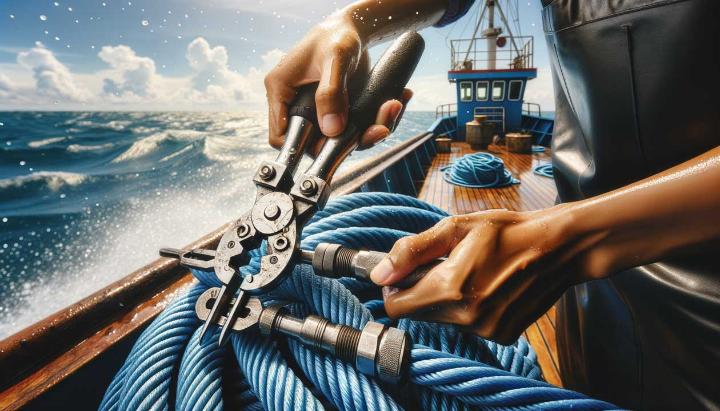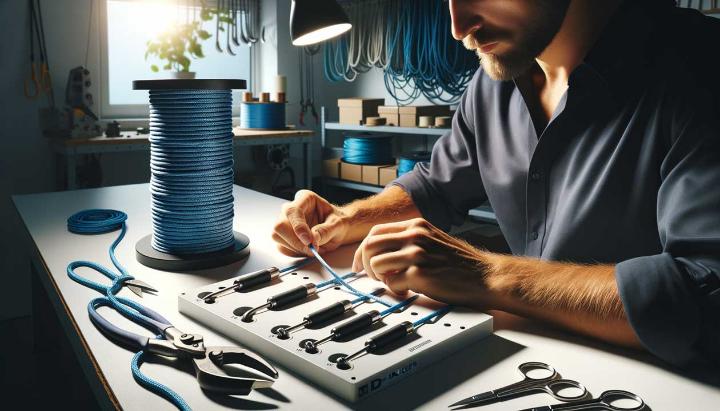Have you ever wondered why some ropes seem to defy the laws of physics, holding up under extreme pressure while others snap at the slightest strain? The secret lies not just in the rope itself, but in how it's spliced. At iRopes, we've cracked the code on maximising rope strength through innovative splicing techniques and cutting-edge tools.
Picture this: a mountaineer dangling from a cliff face, a ship anchored in stormy seas, or a heavy load suspended high above a construction site. In each of these scenarios, rope strength isn't just a matter of convenience—it's a matter of life and death. That's why we've dedicated years to perfecting our proprietary rope splicing method, which minimises strength loss and preserves maximum rope integrity.
In this post, we'll unveil the revolutionary approach that's turning heads in the industry. From our in-house developed splicing technique to our advanced rope and wire rope tools, we'll show you how iRopes is redefining what's possible in rope performance. Whether you're a professional rigger, an outdoor enthusiast, or simply someone who appreciates engineering marvels, you're about to discover why our rope splicing solutions are the gold standard for strength, safety, and durability.
iRopes' Proprietary Rope Splicing Method
When it comes to rope strength, every little bit counts. That's why at iRopes, we've developed a groundbreaking rope splicing method that's turning heads in the industry. Let me take you on a journey through our innovative approach to maximizing rope strength.
Minimizing Strength Loss in Rope Splicing
Picture this: you're scaling a cliff face, and your life literally hangs by a thread. In that moment, you'd want to know that your rope is as strong as it can possibly be, right? That's where our proprietary splicing technique comes into play.
Traditionally, rope splicing results in about a 10% loss in strength. But here's the kicker - our method pushes the boundaries of what's possible. Through meticulous research and countless hours of testing, we've managed to reduce that strength loss to an absolute minimum.

But how do we achieve this? It's all about precision and innovation. Our splicing process has been optimized to retain the maximum rope strength possible. We've fine-tuned every aspect, from the initial cut to the final tuck, ensuring that each fiber contributes to the overall strength of the splice.
Advantages of Advanced Splicing Techniques
So, what does this mean for you? Let's break it down:
- Unparalleled strength retention: Our splices maintain up to 95-98% of the rope's original breaking strength, significantly outperforming traditional methods.
- Enhanced safety: Whether you're in maritime operations, construction, or outdoor adventures, our splices provide an extra layer of security.
- Longer rope life: By minimizing stress points, our splicing technique helps extend the overall lifespan of your ropes.
But don't just take my word for it. We've put our splices to the test in some of the most demanding environments imaginable. From the icy peaks of the Himalayas to the choppy waters of the Atlantic, our ropes have proven their mettle time and time again. Why Amsteel Winch Rope Outperforms Steel Wire Rope is one such example where our ropes excel.
Have you ever wondered how much difference a few percentage points in strength retention can make? In critical applications, it could mean the difference between success and failure, or even life and death. That's why we're so passionate about pushing the boundaries of rope splicing technology.
As we continue to innovate and refine our techniques, we're not just improving ropes - we're redefining what's possible in rope performance. And that's something we're incredibly proud of at iRopes.
Advanced Rope Splicing Tools: Precision and Efficiency in Action
When it comes to rope splicing, having the right tools can make all the difference. At iRopes, we've taken rope splicing to the next level with our advanced tools designed for precision and efficiency. Let me walk you through how these innovative tools are revolutionising the way we approach rope splicing.
Essential Rope Splicing Tools for Professional Results
Imagine you're standing on the deck of a ship, tasked with splicing a crucial mooring line. The success of your splice could mean the difference between a secure vessel and a potential disaster. That's where our advanced splicing tools come into play. Here are some of the essential tools we've developed:
- Precision fids: These tapered metal or plastic tools are the backbone of any splicing kit. Our fids are designed with ergonomic grips and ultra-smooth surfaces, allowing for effortless strand separation and manipulation.
- Innovative pushers: We've reimagined the traditional pusher, creating a tool that not only guides strands into place but also helps maintain consistent tension throughout the splice.
- Specialised splicing needles: Our needles feature a unique flexibile design, making it easier to weave through tight spots without damaging the rope fibres.

Selecting the right tools for your specific rope type is crucial. For example, when working with high-modulus synthetic ropes, you'll want to use our specially coated fids that prevent fibre damage and ensure a clean splice every time.
Mastering Efficient Splicing Techniques with Modern Tools
Now, let's talk about putting these tools into action. I remember the first time I used our advanced splicing kit on a challenging double braid splice. The difference was night and day compared to traditional tools.
Here's a quick rundown of how our tools improve the splicing process:
- Start by using our precision fid to smoothly separate the rope strands. You'll notice how effortlessly it glides through, reducing the risk of fibre damage.
- Next, employ our innovative pusher to guide the core through the cover. Its unique design helps maintain consistent tension, resulting in a more uniform splice.
- Finally, use our flexible splicing needle to weave the final tucks. The needle's design allows for tight, neat finishes even in confined spaces.
But don't just take my word for it. Professional riggers have reported up to a 30% reduction in splicing time when using our advanced tools. This efficiency doesn't just save time – it ensures more consistent, reliable splices across the board.
Have you ever struggled with a particularly tricky splice? Our tools are designed to make even the most complex splicing techniques more manageable. Whether you're working with traditional three-strand ropes or cutting-edge synthetic materials, our tools adapt to your needs.
By investing in these advanced rope splicing tools, you're not just buying equipment – you're investing in precision, efficiency, and ultimately, safety. And isn't that what truly matters when it comes to rope work? Explore more about how to Master Rope Splice Techniques for Your Needs and ensure the best outcomes.
Customized Wire Rope Tools for Specific Applications
In the world of wire rope applications, one size definitely doesn't fit all. That's where customized wire rope tools come into play, offering tailored solutions for a myriad of industries and specific needs. Let's dive into how these specialized tools are revolutionizing the way we work with wire ropes.
Types of Wire Rope Tools for Various Industries
From construction sites to offshore oil rigs, wire ropes are the unsung heroes of many industries. But to harness their full potential, you need the right tools for the job. Here's a glimpse into some of the specialized wire rope tools we've developed at iRopes:
- Swaging tools: These powerful machines compress fittings onto wire ropes, creating secure terminations. We've fine-tuned our swaging tools to handle a wide range of rope diameters and materials.
- Wire rope cutters: Precision is key when cutting wire ropes. Our cutters are designed to make clean, swift cuts without fraying, even on high-tensile strength ropes.
- Socketing devices: For applications requiring a poured socket termination, our socketing tools ensure a perfect fit and maximum strength retention.
But it's not just about having these tools - it's about customizing them for specific industry needs. For instance, our marine-grade swaging tools are built to withstand harsh saltwater environments, while our mining-specific wire rope cutters are designed for heavy-duty, continuous operation in dusty conditions. Learn more about the Polypro Rope Varieties we offer for diverse applications.

Selecting the Right Custom Wire Rope Solution
Choosing the right custom wire rope tools isn't just about picking the fanciest gadget - it's about finding the perfect fit for your specific needs. Here are some key factors to consider:
- Application specifics: Consider the environment, load requirements, and frequency of use. A tool designed for occasional use in a warehouse won't cut it for daily operations on an offshore platform.
- Rope specifications: The diameter, construction, and material of your wire ropes will dictate the type of tools you need. Always ensure your tools are rated for the ropes you're working with.
- Safety standards: Different industries have varying safety requirements. Make sure your custom tools meet or exceed these standards.
Remember, consulting with experts is crucial when it comes to custom wire rope solutions. At iRopes, we work closely with our clients to understand their unique challenges and develop tools that not only meet but exceed their expectations.
Proper maintenance of your custom wire rope tools is also vital for longevity and performance. Regular inspections, cleaning, and calibration (where applicable) will ensure your tools remain in top condition, ready to tackle any job that comes their way.
By investing in customized wire rope tools, you're not just buying equipment - you're investing in efficiency, safety, and the ability to tackle specialized tasks with confidence. Whether you're working on a construction site in Sydney or a mining operation in the Outback, having the right tools can make all the difference.
Essential Rope Splicing Tools for Various Applications
When it comes to rope work, having the right tools can make all the difference. Whether you're a seasoned sailor, an arborist, or a DIY enthusiast, investing in a comprehensive rope splicing kit is crucial for achieving professional-grade results. Let's dive into the world of rope splicing tools and discover how they can elevate your rope work to new heights.
Understanding Different Types of Splicing Equipment
As someone who's spent countless hours perfecting splices, I can tell you that the right tools are worth their weight in gold. Here's a rundown of the essential splicing equipment you'll need:
- Fids: These tapered tools are the workhorses of rope splicing. They come in various sizes and materials, helping you separate strands and create clean passages through the rope.
- Splicing needles: Perfect for intricate work, these flexible needles help you weave rope strands with precision, especially in tight spaces.
- Scissors or cutting tools: A sharp, clean cut is crucial for a professional splice. Invest in high-quality scissors or specialised rope cutters for the best results.
- Pushers: These handy tools help you manipulate rope strands, making it easier to create complex splices without damaging the fibres.
For those working with synthetic ropes like Dyneema, I've found that the D-Splicer kit is a game-changer. Its precision-engineered tools make splicing high-modulus fibres a breeze, even for beginners.

Choosing the Right Rope Splicing Kit for Your Needs
Selecting the perfect splicing kit can be overwhelming, but it doesn't have to be. Consider these factors when making your choice:
- Rope type and diameter: Ensure your kit is compatible with the ropes you commonly work with. Some kits are versatile, while others are specialised for specific materials or sizes.
- Project scale: Are you an occasional splicer or a professional rigger? Your usage frequency will determine whether an entry-level or professional-grade kit is more suitable.
- Splicing techniques: Different splices require different tools. If you frequently perform eye splices or chain splices, make sure your kit includes the necessary equipment.
For beginners, I recommend starting with a comprehensive kit like the Selma Splicing Set. It covers a wide range of rope types and includes detailed instructions, making it perfect for learning the ropes (pun intended!).
Professional marine riggers might want to invest in a more specialised kit. The Marlow Professional Splicing Kit, for instance, is a favourite among yacht riggers for its high-quality tools and durability in harsh marine environments.
Remember, the right tools not only make your job easier but also ensure the safety and longevity of your splices. Whether you're working on a small DIY project or rigging a sailboat, having a well-equipped splicing kit is an investment in quality and peace of mind. For more insights, check out our guide on Mastering Splicing Nylon and Dyneema Rope Techniques.
Have you had any experiences with rope splicing tools that changed your approach to rope work? Share your stories in the comments below – I'd love to hear about your favourite tools and techniques!
Discover Our Cutting-Edge Rope Splicing Solutions
Elevate your rope work with iRopes' proprietary rope splicing tools and methods designed to minimize strength loss and maximize durability. Our advanced rope tools ensure precise and efficient splicing, enhancing performance and longevity. Explore our customised wire rope tools tailored for various applications and materials, providing optimal results for your specific needs. With a comprehensive range of rope splicing tools, iRopes empowers you to achieve professional-grade outcomes for any project. Fill out the form above to learn more about how our rope tools and wire rope tools can transform your work.